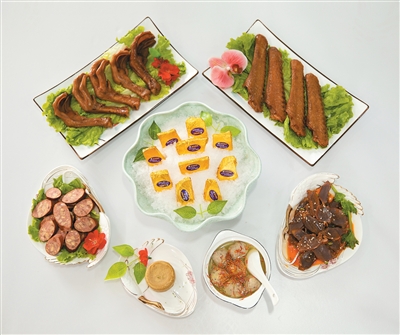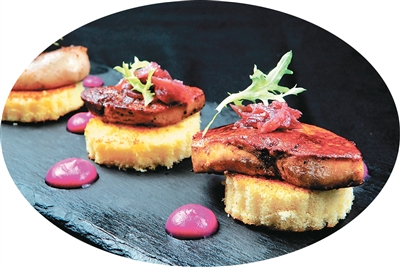Linqu county in Weifang city, east China's Shandong Province has emerged as an unlikely global powerhouse, producing one-fifth of the world's foie gras, a delicacy often associated with France, annually.
Jia Liwei, a 44-year-old native of Linqu, has witnessed this evolution. For more than two decades, he has raised geese in his hometown, becoming part of the foie gras industry in the county. Jia specializes in breeding Landes geese, a world-renowned variety from France's Landes region, prized for producing premium foie gras.
Landes geese have thrived in Linqu county's climate, which shares the similar latitude as Landes and offers ideal conditions for Landes geese breeding.
The county's foie gras industry began in the 1980s when local farmers were funded by European companies to experiment with breeding Landes geese and favorable policies were introduced by China.
A pivotal moment came in 1991 when Linqu established its first local foie gras production and processing enterprise, a Chinese-foreign joint venture. The company imported 3,000 Landes geese from France and, in its first year, produced 50 tonnes of foie gras, all of which were exported to Japan.

Photo shows foie gras delicacies. (Photo courtesy of Zhang Shuning)
In March 1993, Linqu was designated a national goose breeding base, marking the foie gras industry's transition to large-scale production. Today, the county is home to 105 foie gras processing and support enterprises.
"Seeing my neighbors prosper from goose breeding, I decided to give it a try," said Jia, who began his entrepreneurial journey in 1998. Initially, he raised three to four batches of goslings annually, with each batch numbering over 1,000. This earned him an annual income of 50,000 to 60,000 yuan ($6,975-$8,370), marking his first taste of success.
Over the years, a comprehensive foie gras industrial chain has taken shape in Linqu, encompassing breeding farms, hatcheries, and processing companies producing various foie gras products.
The county now processes 5 million Landes geese annually, producing over 5,000 tonnes of foie gras. This accounts for nearly 70 percent of China's domestic market and 20 percent of global production, with an annual output value exceeding 8 billion yuan.
"Thanks to the complete industrial chain and improved business models, my annual income has soared to 500,000-600,000 yuan," Jia said.
The industry's growth has been fueled by technological innovation and product diversification. Shandong Chunguan Food Co., Ltd., founded in 1999, exemplifies this trend. In late 2017, the company formed a research team, attracting over 30 PhD holders in food science to seek breakthroughs in foie gras deep processing and quality enhancement.

Photo shows foie gras delicacies. (Photo courtesy of Zhang Shuning)
After more than a year of independent research and development (R&D), the company launched a foie gras product infused with red wine and blueberry flavors in December 2018, which quickly gained market popularity. Without increasing production volume, Chunguan doubled its revenue that year. Since then, more varieties have been introduced, pushing the company's output value from about 30 million yuan in 2018 to nearly 400 million yuan in 2024.
By focusing on deep processing and investing heavily in R&D, Shandong Zunrun Sanrougey Food Co., Ltd. has also reaped significant rewards. Its self-developed fifth-generation semi-automatic feeding machine, equipped with intelligent sensors, automatically adjusts feeding amounts and frequency, ensuring uniform nutrition for each goose. Put into use in June 2023, the machine has boosted production efficiency by more than fivefold.
In the past two years, over 20 delegations from countries including Hungary and Poland have visited Sanrougey for exchanges and collaboration. "They're interested in adopting our semi-automatic feeding technology," said Gao Yuanliang, the company's general manager.
To meet evolving consumer preferences, Sanrougey has diversified its product line. It developed foie gras hot pot products, which sold 10 tonnes last year, becoming a new driver of profits.
Global expansion has become a focus for local enterprises. Four years ago, Chunguan Food began targeting overseas markets. "Foreign demand for fresh foie gras is six times that of cooked products. We are confident about 'going global' and exploring overseas markets," said Ma Lijun, the company's general manager.
To facilitate exports, the Linqu county government has organized participation in major international exhibitions such as the HKTDC Food Expo. To meet international standards for fresh foie gras exports, Chunguan has invested 50 million yuan in building an export-compliant slaughter line, set to begin operations soon.
This year, enterprises in Linqu have taken part in over 10 overseas exhibitions, driving foie gras export revenues to 20 million yuan, up 19.2 percent year on year.
While importing high-quality Landes geese, Linqu is also striving for the self-sufficiency of breeding stock through independent R&D.
Wei Shujuan, director of Linqu county's agriculture and rural affairs bureau, said the county will import purebred Landes geese from France in a timely manner while continuing to advance breeding technology research in collaboration with institutions such as the Chinese Academy of Agricultural Sciences, aiming to establish indigenous Landes geese breeding systems.
Currently, Linqu has ramped up standardized breeding, constructing over 650 standardized breeding facilities. Over the past five years, it has organized more than 120 training sessions, reaching nearly 1,000 local breeders.
"Looking ahead, we'll continue to promote standardized breeding and focus on brand development and enhancing the foie gras industrial chain. We aim to cultivate local enterprises and attract leading companies to help Linqu's goose industry reach the 10-billion-yuan milestone," said Liu Yanfang, Party chief of Linqu county.
(Source: People's Daily)
